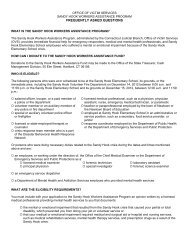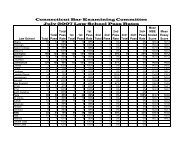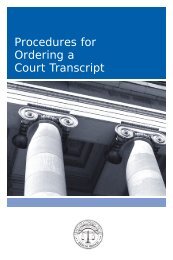Biennial activities report - Connecticut Judicial Branch - CT.gov
Biennial activities report - Connecticut Judicial Branch - CT.gov
Biennial activities report - Connecticut Judicial Branch - CT.gov
You also want an ePaper? Increase the reach of your titles
YUMPU automatically turns print PDFs into web optimized ePapers that Google loves.
Victim assistance programs funded with VOCA<br />
victim assistance and state appropriated funds were<br />
awarded to service providers based upon the 4<br />
priority categories of victimization as established by<br />
the U.S. Department of Justice, Office for Victims of<br />
Crime (See Table 2). The priority categories are:<br />
∝ Child abuse<br />
∝ Domestic violence (includes child witnesses)<br />
∝ Sexual assault<br />
∝ Previously underserved victims of various crimes<br />
(includes assault, robbery, hate and bias crimes,<br />
adults molested as children, intoxicated driving,<br />
elder abuse, family members of homicide victims,<br />
abuse of vulnerable adults, gang-related crimes,<br />
stalking, federal crimes, economic exploitation,<br />
and fraud)<br />
Types of Services Supported by Grant Funds<br />
During this biennium, VOCA funds were used by<br />
subcontracting agencies to provide crime victims with<br />
a variety of services (See Table 3). The largest<br />
percentage of awarded funds were for advocacy based<br />
programs, however OVS provided funding for<br />
therapy programs for adults and children, on-scene<br />
crisis response for child victims of crime, and<br />
translation and interpreting services for non-English<br />
speaking crime victims.<br />
Advocacy programs provided services to victims in<br />
courts, shelters, specific towns and neighborhoods, or<br />
on a statewide basis through the use of regional<br />
offices. These programs provided victims with crisis<br />
counseling, safety planning, assistance with basic<br />
needs, assistance with filing compensation<br />
applications, information and referral to other social<br />
service agencies, assistance in court, and translation<br />
and interpreting services. Subcontracting agencies also<br />
worked with OVS victim services advocates.<br />
OVS also awarded funding to agencies that<br />
provided free therapy services to child and adult<br />
victims of crime. These services included the initial<br />
psychiatric evaluation, individual and group therapy<br />
sessions, follow-up, referral to other services, and<br />
assistance with completing applications for victim<br />
compensation. Most of the programs offered<br />
short-term therapy, and if the victim was eligible for<br />
compensation, he or she could receive additional<br />
therapy to be reimbursed or paid for by the<br />
Compensation Program.<br />
OVS funded programs also provided training to<br />
service providers and the general public about human<br />
trafficking and its effects on crime victims. The<br />
purposes of the trainings were to provide information<br />
on the types of human trafficking crimes, the impact<br />
on victims of human trafficking, and how to access<br />
services for these crime victims.<br />
On July 1, 2011, the Assistance to Family Members<br />
of Homicide Victims program expanded to include 3<br />
new nonprofit victim service agencies that are<br />
providing expanded coverage throughout the state.<br />
Previously, services were limited to the Greater<br />
Hartford and New Haven areas.<br />
Subcontractor Monitoring<br />
In keeping with the responsibility to ensure that<br />
grant funds are expended in accordance with federal,<br />
state, and <strong>Judicial</strong> <strong>Branch</strong> regulations, as well as OVS<br />
policies and procedures, the Grants and Contracts<br />
Unit continued its on-site subcontractor monitoring<br />
during this biennium. Thirteen site visits were<br />
conducted during this biennium. The site visits were<br />
designed to ensure that the funded programs operate<br />
in accordance with the contract and to provide<br />
technical assistance, if needed, to the service<br />
providers.<br />
Forensic Evidence Collection<br />
Effective November 1, 2009, responsibility for<br />
payment for costs related to forensic evidence<br />
collection and forensic exams was transferred from the<br />
Division of Criminal Justice to OVS. Hospitals are<br />
reimbursed up to $900 for eligible expenses related to<br />
the examination and collection of forensic evidence<br />
for adult victims of sexual assault. Forensic exams for<br />
younger victims are also reimbursed up to $900 for<br />
eligible expenses. During this biennium, OVS<br />
reimbursed hospitals $1,899,917 for forensic evidence<br />
collection for 660 adult sexual assault victims and<br />
1,672 sexual assault victims who were under the age<br />
of 18.<br />
21
















